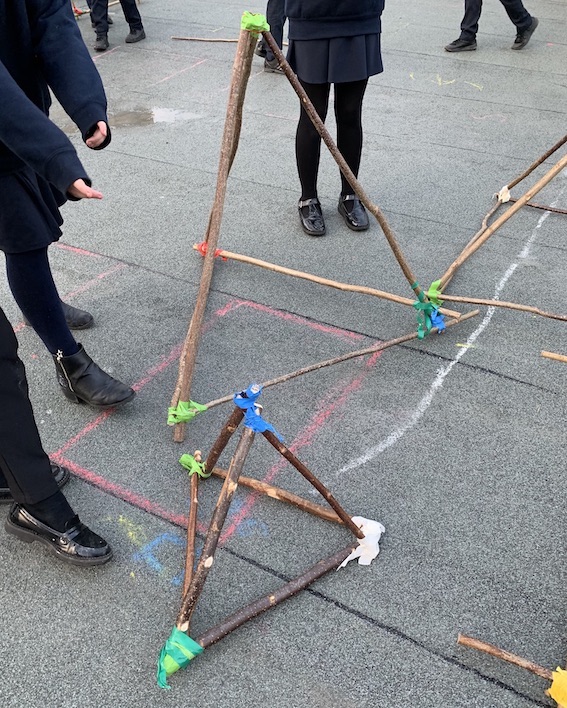I love learning outside for many reasons, not least because I’m a seeker of “Divine Aha!” moments. This is when the light dawns or a spark of an idea catches alight and sets my mind on fire.
This post was originally written in March 2012. At that point I had been using sticks for a couple of years and was quite bowled over as their potential as a mathematical resource. The Muddy Faces website sold one-metre sticks. I had bought one or two, made my own and also had a donation from Cosy. So my collection of 1-metre sticks was substantial.

In the past I had made skeletons and nets from bamboo canes. I have to tell you that they are the poor relatives of real sticks. The bamboo is tricky to link together, even using the balls and connectors that are commercially available. In the past I’d used lot of masking tape with classes and created a lot of frustration when using bamboo.

Many of my metre-long sticks have holes drilled in either end. This means that little fingers can use washing line or paracord or similar to tie the sticks together without having to know their lashing knots beforehand. Different structures can be experimented with and in the process children are learning about the structure of 3D shapes as well as the technology aspects of den building.
The photos above and below from from my “Maths Sticks” workshop at the 2012 Grounds for Learning NatNet Conference. One group of participants had to create the biggest 3D shape using the 1-metre sticks which would hold its shape and not collapse.

Whilst investigating 3D skeletons is an upper primary activity by tradition, I’m sure many pre-school practitioners would agree that this sort of challenge is something that some younger children really enjoy. I’ve noticed this before when working on maths challenges outside. It seems that upper primary expectations are best begun in a play context earlier on which enables children to have the pre-requisite concrete experiences. In turn this leads to understanding, creating and applying the skills learned once the children become older. Furthermore this is far more challenging than a set of plastic polyhedrons that click together which is often the norm in many classrooms.
A natural progression from simply building 3D structures is to create their 2D nets on the ground before hand and move this into a 3D structure. Remember there are 11 possibilities alone for a cube!
2020 Update: 10 top tips

Since 2012, I’ve had several opportunities to continue to experiment with building the nets of 3D objects. Here’s some things I’ve learned:
- This remains an absorbing, challenging and useful approach to helping children understand nets, scale and how 3D objects are created.
- Plan what you want to do with the finished nets. Some may need to be dismantled, but they work well for den-building in nursery classes. Also they also speak to me as wonderful sculptures waiting to be decorated for a special event such as Christmas.
- I still have my original one-metre stick collection. I still get opportunities to cut sticks to replenish as needed. They remain a wonderful resource and a long-term investment if looked after well. In the photo above, 24 children were in the class. The school had over 100 one metre sticks which was plenty for working in trios. Cubes and cuboids require the most sticks. 60 is a good number for six basic nets. Remember if you don’t have that many, then create small nets.
- Bamboo sticks remain a poor relative. Avoid if at all possible.
- Masking tape works fine with the sticks. String, twine, paracord or washing line may also be used. Electrical tape also works but this is a single-use plastic so probably best avoided for this activity.
- If you can teach your children to do a good lashing first, then it’s better and stronger structures will be created.
- Many children are flummoxed at the practical element and the need to problem solve. Giving them a wee 3D object to look at, count the edges and to help them plan their approach can help, For instance, I don’t hand out sticks to groups until they have correctly identified the number that they need to create their particular shape.
- The triangular prism, square-based pyramid and tetrahedron are the easiest to create and most robust. Therein lies the STEM connection and that if we look at how structures such as bridges are created, what shapes or styles seem to bear weight or maintain their rigidity?
- Cuboids needs 50cm sticks too. It can be useful to have two different cuboids constructed for comparative purposes.
- Introduce 50cm and 25cm stick lengths to demonstrate scale. Children are always amazed that a 50% reduction in stick length creates such a small version. It helps them better understand the concept of scale. It also means that if you have a group that are not able to manage the responsibility of using one-metre sticks, they can still have a good practical experience working on the smaller structures. Or if you don’t have lots of one-metre sticks then smaller versions can be constructed. Below is a photo that shows 50% scaling.

So once again, sticks are making maths ever-more interesting outside. Long may the creative potential of sticks be celebrated and enjoyed.




















Hi! What a wonderful session you had here. The kids seem to be so engaged! We’ve designed a tool making it easier for small hands to connect sticks. Stick-lets are durable, reusable and flexible (you can collapse most the structure with the joints in place!). You can find us in Forest School supply catalogs or feel free to reach out and we’ll happily connect you to some vendors! =)
Thanks Christina – I’ve known about stick-lets for a number of years and pleased that all is going well with your product.